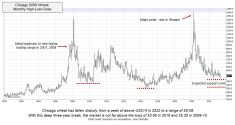Ontario farmers had planted 75 per cent of the corn crop and approximately 48 per cent of the soybean crop as of May 17.
Over the past 30 days, the Ontario crop region has received less than 60 per cent of normal precipitation and temperatures have been five to 10 degrees Celsius below normal. While planting progress is in line with the five-year average, the row crops have been slow to emerge. Seasonal temperatures arrived by late May and mid-month rain will help crop development.
Quick look
Soybeans: Soybean acreage will likely be down slightly in Ontario this year.
Read Also

Scouting advised for soybean aphids
Soybean aphids have been spotted in a few fields in southern Ontario that haven’t seen soybean aphids in quite a…
Wheat: U.S. hard red wheat production expected to decline for 2020.
We’re rating the Ontario winter wheat crop 60 per cent good to excellent as of May 17, unchanged from two weeks ago. The Statistics Canada crop survey came in close to expectations for soybeans but corn acreage was higher than our earlier projections. Winter wheat acres remaining after the winter were in line with trade forecasts.
Elevator and ethanol processor bids for corn are relatively unchanged from earlier in May; soybean prices are about 10 cents per bushel higher while winter wheat bids are down 10 to 15 cents per bushel. The USDA May WASDE report was considered bearish for corn but neutral for soybeans and wheat. Given the earlier planting progress, the USDA is factoring in trend type yields at this time of year for the row crops. European winter wheat conditions have improved but timely rains are needed in the Ukraine and Russia. However, the wheat market is under pressure with the Northern Hemisphere winter wheat harvest right around the corner.
Outside influences are currently supportive for the grain and oilseed markets. We’ve seen a slight recovery in energy values and the ethanol grind has improved since late April. The reopening of world economies after the COVID pandemic has also been positive news.
The Canadian dollar is relatively unchanged from early May but we still have a bearish outlook for the resource-based currency. The manufacturing slowdown in central Canada appears to be sharper than earlier anticipated.
Soybeans
Ontario farmers intend to plant 2.889 million acres of soybeans according to Statistics Canada. This is marginally lower than our estimate of three million acres and down from the 2019 planted area of 3.115 million acres. Using a five-year average yield, production for 2020 has potential to finish near 3.6 million tonnes, similar to the 2019 output which was 3.7 million tonnes. The five-year average soybean production in Ontario is three million tonnes.
U.S. farmers had planted 53 per cent of their intended soybean acres as of May 17, which compares to 16 per cent last year and the five-year average of 38 per cent. The USDA estimated 2020 soybean production at 112 million tonnes, up from the 2019 crop size of 97 million tonnes. The South American soybean harvest is wrapped up. Argentina’s crop was estimated at 51 million tonnes, down from the 2019 production of 55 million tonnes.
Brazilian production has been trimmed to 124 million tonnes, down from earlier spring estimates around 126 million tonnes but still up from last year’s crop size of 117 million tonnes. Brazilian farmers have been active sellers due to the deterioration of their domestic currency.
The Brazilian real has dropped nearly 50 per cent from the beginning of the year. China has been an active buyer of Brazilian soybeans while trying to fulfil its commitments of U.S. origin beans under the “phase one” trade agreement. The year-over-year increase in U.S. production along with aggressive selling from the Brazilian farmer has weighed on Ontario soybean prices.
Moving forward there are three factors that could cause a minor rally in the soybean market. First, Brazilian farmers cannot keep up the aggressive selling pace. This weight on the market will be alleviated. Secondly, U.S. growing conditions are favorable and there is no weather premium in the market.
Finally, the opening of world economies and improving demand for vegetable oils will be supportive for the oilseed complex.
What to do: We’ve advised farmers to be 80 per cent sold on old crop and 20 per cent sold on new crop. We may see a minor rally in the soybean market over the next month and we’ll wait until the upcoming crop is more certain before making our final sales recommendation.
Corn
According to Statistics Canada, Ontario farmers intend to seed 2.302 million acres of corn this spring, up from 2019 seeded area of 2.203 million acres. Using a five-year average yield of 159 bushels per acre, production has potential to finish around 9.1 million tonnes, up from the 2019 crop size of 8.6 million tonnes.
The ethanol grind has improved on both sides of the border which has supported local cash prices; however, export demand for Ontario corn remains quiet. Domestic Ontario corn prices remain elevated compared to world values.
As of May 17, U.S. farmers seeded 80 per cent of their intended corn acres, up from last year’s pace of 44 per cent and up from the five-year average of 71 per cent. The USDA used a trend yield of 178.5 bushels per acre in their production estimate, which came in at 406 million tonnes, up from the 2019 crop size of 347 million tonnes. U.S. seeding is in the final stages and traders are focusing on weather and crop development. Short to medium range forecasts look favorable for the Midwest. At the same time, Brazil’s second crop corn harvest will move into full swing in June.
Brazil’s crop was estimated at 101 million tonnes on the May WASDE report, unchanged from last year; Argentina’s crop was forecasted to reach 50 million tonnes, also unchanged from year-ago levels. There is a very strong seasonal tendency for corn prices to trend lower from June through mid July. During the U.S. pollination period in July, we may see a minor temporary rally. However, corn supplies will be burdensome this fall.
What to do: In my previous article, we advised producers to finish old crop sales. Ontario cash prices are reflecting a 20 cent per bushel inverse between old and new crop prices. The market structure is telling farmers to sell now and not store into new crop positions. Keep in mind we are also 20 per cent sold on new crop. World corn supplies are projected to be extremely burdensome for the 2020/21 crop year. Our strategy is to make timely sales on seasonal swings in demand.
Wheat
Statistics Canada estimated remaining winter wheat acres at 1.080 million, which is up from the 2019 remaining acres of only 656 million. Using a five-year average yield, Ontario winter wheat production is expected to finish near 2.5 million tonnes, similar to our earlier estimate and up from the 2019 production of 1.4 million tonnes.
Ontario farmers intend to seed 94,600 acres of spring wheat, similar to last year. We may see this number increased as our contacts suggest farmers switched some row crop acres into spring cereals.
The USDA provided its first estimate of winter wheat production on the May WASDE report. U.S. soft red winter wheat production was estimated at 8.1 million tonnes, similar to our earlier estimate and up from 6.5 million tonnes last year; U.S. hard red winter wheat production was estimated at 20 million tonnes, down from our earlier estimate of 22 million tonnes and down from the 2019 output of 22.7 million tonnes.
Timely rains have sustained Ukraine and Russian wheat production estimates. The USDA had Russian production at 77 million tonnes, up from 74 million tonnes last year.Ukraine production was estimated at 28 million tonnes, down one million tonnes from the 2019 output. Export restrictions are not having an effect on the wheat market at this time of year for two reasons.
Most major buyers have 45 to 60 days of coverage. Secondly, the new crop starts July 1 so there is no demand in the short term. When demand does show up, supplies will be plentiful. Total European wheat production is estimated at 143 million tonnes, down from 155 million tonnes last year. We’re looking for upward revisions in Europe due to favorable rains in France and Germany over the past month.
The wheat market is expected to trend lower through June and remain under pressure during July and August. At this time, Russian wheat offers f.o.b. the Black Sea are about US$20 per tonne lower than U.S. offers out of the Gulf. Russian and Ukraine farmers are usually aggressive sellers during the harvest period, which will move into high gear during July.
Remember, U.S. winter wheat farmers also sell 50 per cent of their crop during the summer months. The lowest wheat prices of the year tend to occur in late July or early August. This is when we tell buyers to step forward for their next four to six-month requirements. Basis levels are usually very weak during the summer as well. You don’t want to be selling wheat in the summer months.
What to do: In a previous article, we advised producers to finish up old crop sales. Keep in mind we are 20 per cent sold on new crop. The function of the Ontario and world wheat market over the next four months is to encourage demand through lower prices.















